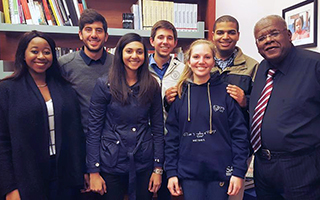 Members of the cohort with the
Vice-Chancellor and Rector of the UFS,
Prof Jonathan Jansen |
Every year, since 2012, six second-year Kovsies are selected to take part in the elite Stanford Sophomore College Programme at the prestigious Stanford University in the United States. The University of the Free State and Oxford University are the only non-Stanford members of this exclusive course.
From 31 August to 15 September 2015, Farzaana Adam, Cornel Vermaak, Precious Mokwala, Tristan Van Der Spuy, Anje Venter, and Naushad Mayat undertook a three-week long academic exploration of multidisciplinary topics. These students attended seminars aligned with their respective fields of study from which they accumulated a wealth of knowledge.
This year’s cohort reflects on what they learned at Stanford University:
The significance of analyzing technology
One of the key points gathered by Farzaana Adam from the seminar, ‘Great Ideas in Computer Science’, was the necessity not to approach technology at face value. “Computer science goes beyond the technological products and social networks. By analysing the concepts underlying these technologies, many discoveries which have benefitted many fields of study have been made possible.”
Critical thinking in Arts and Science
“By combining different fields of study, one can obtain a greater perspective on the relevant fields,” said Cornel Vermaak, about what he garnered from a seminar titled ‘An Exploration of Art Materials: An intersection between the Arts and Science’. “This greater perspective enables one to evaluate problems critically,” he added.
Visual media substitutes oral narratives
“We were also taught different ways in which to interpret images, and how images influence society. Photography is a way to tell a story without actually having to say anything,” reflected Precious Mokwala, on ‘Photography: truth or fiction’
A lesson in business economics
Tristan Van Der Spuy received pointers pertaining to the stock exchange market in ‘A Random Walk Down Wall Street’. “We looked at stock markets, and what influenced the stock prices of multiple companies, taking note of what should be looked at when investing in a company.”
Race relations and representation
‘The New Millenium Mix: Crossings between Race and Culture’ exposed Anje Venter to a global perspective on identity. “We explored the new generation of people that have mixed races and cultures, and how they are depicted in media and art. We analysed the discrepancies and stereotypes of these depictions through film, novel, and short story studies, as well as through field trips to museums and art exhibitions.”
Overcoming the HIV/AIDS endemic
Naushad Mayat realised that “more teamwork and transparency between governments, chemists, social workers, and clinicians will be required for us to stem the flow [of HIV/AIDS],” in view of what he learned in a seminar on ‘HIV/AIDS: A Response to the AIDS Epidemic in the Bay Area’. “It is a daunting task. For the current generation of youth to tackle this epidemic now, we must stand together and be counted,” he added.